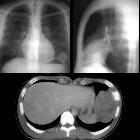Tumoren der Rippen

Tumor and
tumorlike conditions of the pleura and juxtapleural region: review of imaging findings. Diagnosis: Ewing sarcoma. Technique: standard chest radiography and contrast-enhanced chest CT. Description: A 23-year-old man was referred for a chest radiograph due to pain at the right hemithorax. The postero-anterior chest radiographs (a, b) show an opacity (arrow) projecting at the level of the 7th right rib. An external radio-opaque marker was placed on the painful area. The additional contrast-enhanced CT further characterizes the mass encasing the 7th right rib with a locoregional aggressive periosteal sunburst type reaction and a surrounding soft tissue component (c, d). On the axial T1-weighted MR image (e) the lesion has an isointense signal to muscle and a high signal intensity on the axial FS T2-WI (f) with invasion of the muscles of the chest wall (arrows). After intravenous contrast administration, the lesions show a heterogeneous enhancement (g), predominantly at the periphery of the lesion. The coronal T2-weighted MR image (h) shows the extrinsic impression of the lesion on the liver

Osteoblastoma
of the rib with CT and MR imaging: a case report and literature review. CT reveals a lytic lesion in right fifth posterior rib with ossified matrix.

Osteoblastoma
of the rib with CT and MR imaging: a case report and literature review. MR finding in right fifth posterior rib. MR imaging shows isointensity on a T1-weighted image (a), heterogeneous high signal pattern with a low signal rim on a T2-weighted image (b) and Coronal STIR imaging (c)

Chondromyxoid
fibroma of rib with a novel chromosomal translocation: a report of four additional cases at unusual sites. Computed tomography scan of chest (case no. 2) demonstrating a radiolucent lesion of the right anterior second rib with cortical bubbling or blebbing, and without radiographic evidence of an acute fracture, calcification or malignancy (arrow). R indicates right side.

Teenager with
fever and left pleuritic chest pain. CXR PA and lateral (above) show a round mass on the lateral and middle aspect of the dome of the left hemidiaphragm. Axial CT with contrast of the chest (below) shows the soft tissue mass to be arising from a rib which has extensive and aggressive periosteal reaction.The diagnosis was Ewing sarcoma of the rib (Askin tumor).

Tumor and
tumorlike conditions of the pleura and juxtapleural region: review of imaging findings. Diagnosis: chondrosarcoma. Technique: contrast-enhanced chest CT and MRI. Description: A 64-year-old woman with a history of smoking, presented due to shortness of breath. The axial contrast-enhanced CT scan (a, b) reveals an expansile lesion with extensive calcifications located at the costochondral junction of the right 3rd rib (note a typical arc-and-ring pattern of calcification). On the axial T1-weighted MR image (c) the lesions have a high signal intensity. The axial T2-weighted MR image (d) shows a peripheral hyperintense mass with internal low-intensity foci, reflecting the cartilaginous matrix with chondroid calcifications

Tumor and
tumorlike conditions of the pleura and juxtapleural region: review of imaging findings. Diagnosis: osteosarcoma. Technique: standard chest radiography and contrast-enhanced chest CT. Description: A 50-year-old man presented with complaints of right-sided chest pain. The postero-anterior chest radiograph (a) shows a large mass located at the lateral side of the right hemithorax with an associated pleural effusion. Note also a lytic expansion of the 8th left rib. The axial contrast-enhanced CT in the mediastinal window setting (b) confirms the heterogeneous mass with intralesional necrosis and calcifications originating from the 7th right rib, with focal expansive destruction, best seen in the bone window (c). There is a known pleural effusion with adjacent compression atelectasis of the right lower lobe. Histopathologic examination of the large mass confirmed the diagnosis of an osteosarcoma. The expansive tumorlike lytic lesion of the 8th left rib corresponds with fibrous dysplasia

Intraossäres
Hämangiom der 1. Rippe links in der Computertomografie links axial im Weichteilfenster mit Darstellung von fettisodensen Anteilen und rechts paraxial im Verlauf der Rippen mit Darstellung der vergröberten Trabekelstruktur der Spongiosa.

Zoledronic
acid in metastatic chondrosarcoma and advanced sacrum chordoma: two case reports. a Thoracic CT scan in the patient with chondrosarcoma shows at right the lesion involving muscles and ribs. Lung metastases were visualized. b Coronal section displays the large tumor.

School ager
with right scapular and right chest pain. CXR AP and lateral (above) show a large right sided chest mass whose obtuse angles with the chest wall suggest it is extrapleural in origin. Axial CT without contrast of the chest (below) shows the mass to be arising from a rib and to be causing periosteal reaction.The diagnosis was Ewing sarcoma of the rib (Askin tumor).
Tumoren der Rippen
Siehe auch:
- Läsionen der Rippen
- Chondrosarkom der Rippen
- Knochentumoren
- Morbus Paget der Rippen
- Rippenmetastasen
- Fibröse Dysplasie der Rippen
- Enchondrom der Rippen
- Ewingsarkom der Brustwand
- hypodense Auftreibung des Rippenknorpels
- Osteosarkom der Rippen
- Osteoblastom der Rippen
- hypodenses Zentrum des Rippenknorpels
und weiter:

 Assoziationen und Differentialdiagnosen zu Tumoren der Rippen:
Assoziationen und Differentialdiagnosen zu Tumoren der Rippen:




